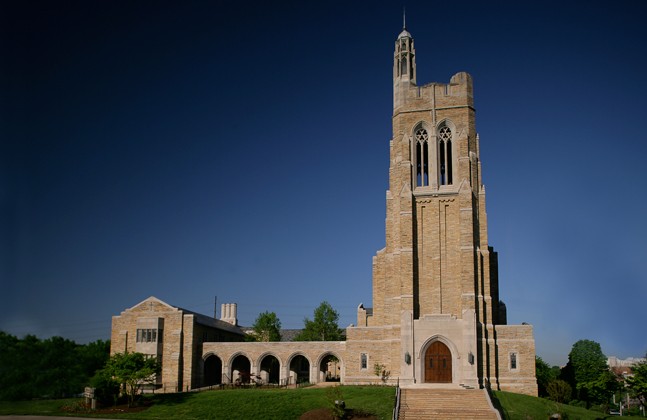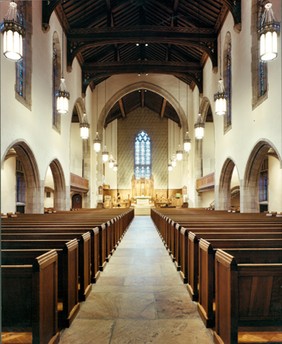Church Street United Methodist Church
Introduction
Text-to-speech Audio
A Knoxville landmark, Church Street United Methodist opened in 1931, replacing a previous Gothic structure that had been located on Church Street between Walnut and Market Streets and destroyed by a fire two years prior. The congregation hired New York architect John Russell Pope to design their new church. Pope's previous work included buildings on the campus of Yale University as well as several other churches for large congregations in major cities. The building has been listed on the National Register of Historic Places since 2009, both for its architecture and its stained glass--commissioned by the same firm that created the stained glass windows of St. Patrick's Cathedral and several other prominent churches in New York.
Images
The large tower at the entrance dominates the sandstone structure and has become the most well-known physical aspect of the church building.

The sanctuary features features ornate stained stained glass windows brought to the city from a Boston manufacturer who designed the windows of many other leading church edifices.

Backstory and Context
Text-to-speech Audio
The congregation dates back to 1816 with 68 members meeting at the city's first Methodist church on East Hill Avenue. Twenty years later, the congregation completed a new edifice on Church Street (Church Avenue today), leading to the congregation's name. During the Civil War, that church served as a hospital. More importantly, members of the congregation who supported the Union left the congregation, creating the First Methodist Church. Members of the Church Street congregation continued to align with the Southern Methodists.
In February 1928, a fire destroyed the building on Church Street, leading to plans to create this structure on nearby Henley Street. In the three years prior to the completion of this church, the congregation met at the Lyric Theater while Sunday School was held at the downtown YMCA.
In February 1928, a fire destroyed the building on Church Street, leading to plans to create this structure on nearby Henley Street. In the three years prior to the completion of this church, the congregation met at the Lyric Theater while Sunday School was held at the downtown YMCA.
Sources
Church history website, http://www.churchstreetumc.org/visitors_history
